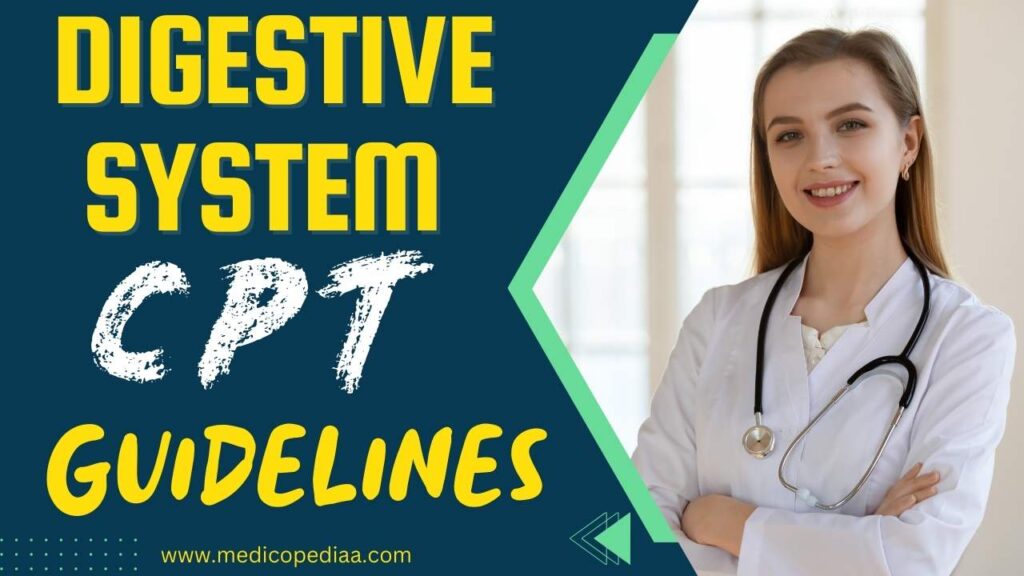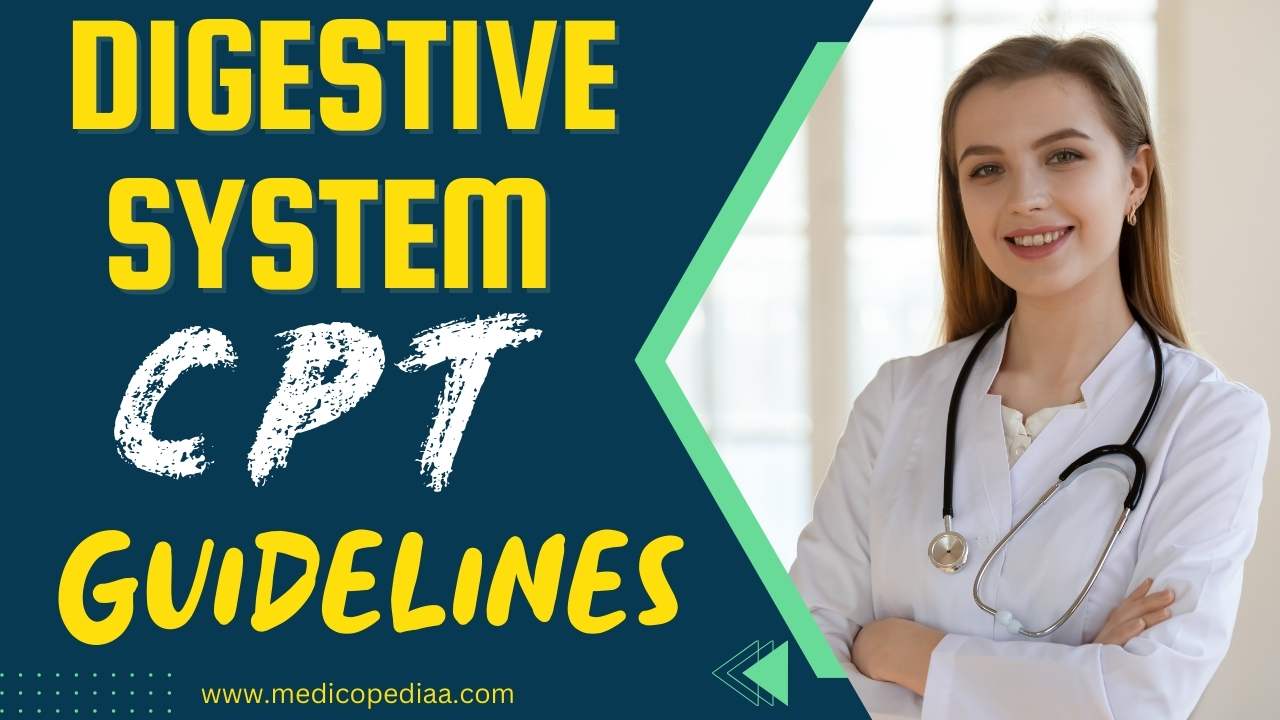Digestive System CPT Guidelines 2024
Hello Reader , In this Article we explain all about Digestive System CPT Guidelines 2024 updates in an easy way you can find codes and any updates related to Digestive System CPT Guidelines and the code range of digestive system cpt guidelines, and also you get modifier details that are used during the coding of digestive system cpt guidelines. Digestive system cpt code range start from 40490 – 49999. There are many modifiers used in digestive system CPT guidelines, which are explained in this article in a very easy way with appropriate examples.

What is Digestive System ?
Your digestive system is a network of organs that help you digest and absorb nutrition from your food. It includes your gastrointestinal (GI) tract and your biliary system. Your GI tract is a series of hollow organs that are all connected to each other, leading from your mouth to your anus. Your biliary system is a network of three organs that deliver bile and enzymes through to your GI tract your bile ducts.
Note : What is the Full form of GI tract ?
GI tract full form is Gastrointestinal tract.
Parts of Digestive System:
(A) The GI tract consist of –
Mouth
Pharynx
Esophagus
Stomach
Small Intestine
Large Intestine
Rectum
Anus
(B) The Accessory Organs consist of-
Salivary gland
Gall bladder
Liver
Pancreas
The GI tract consist of :-
Mouth : The mouth is the beginning of the digestive tract. In fact, digestion starts before you even take a bite.
Pharynx: A fibromuscular y-shaped tube attached to the terminal end of the mouth. It is mainly involved in the passage of chewed/crushed food from the mouth through the oesophagus.
Esophagus: Located in your throat near your trachea (windpipe), the esophagus receives food from your mouth when you swallow.
Stomach: The stomach is a hollow organ, or “container,” that holds food while it is being mixed with stomach enzymes.
Small intestine: Made up of three segments — the duodenum, jejunum, and ileum — the small intestine is a 22-foot long muscular tube that breaks down food using enzymes released by the pancreas and bile from the liver.
Large Intestine: The colon is responsible for processing waste so that emptying your bowels is easy and convenient. It’s a 6-foot long muscular tube that connects the small intestine to the rectum.
The colon is made up of the cecum, the ascending (right) colon, the transverse (across) colon, the descending (left) colon, and the sigmoid colon, which connects to the rectum.
Rectum : The rectum is a straight, 8-inch chamber that connects the colon to the anus. The rectum’s job is to receive stool from the colon, let you know that there is stool to be evacuated (pooped out) and to hold the stool until evacuation happens.
Anus: The anus is the last part of the digestive tract. It is a 2-inch long canal consisting of the pelvic floor muscles and the two anal sphincters (internal and external). The lining of the upper anus is able to detect rectal contents. It lets you know whether the contents are liquid, gas or solid.
B) The Accessory Organs consist of-
Salivary gland : Three pairs of major salivary glands (parotid, submandibular, and sublingual glands) and numerous smaller ones secrete saliva into the oral cavity, where it is mixed with food during mastication. Saliva contains water, mucus, and enzyme amylase.
Gall bladder : The gallbladder is a pear-shaped sac that is attached to the visceral surface of the liver by the cystic duct. The principal function of the gallbladder is to serve as a storage reservoir for bile. Bile is a yellowish-green fluid produced by liver cells. The main components of bile are water, bile salts, bile pigments, and cholesterol.
Liver : The liver is a roughly triangular, reddish-brown accessory organ of the digestive system located to the right of the stomach. It produces bile, which helps in the digestion of fat in the small intestine.
Pancreas: It is a large gland present just behind the stomach. It is short with its anterior connected to the duodenum and posterior pointing towards the left part of the abdominal cavity.
Gastr/o – stomach
Chol/e – Gall
Cyst/o – Bladder, Sac
Emes/o – Vomit
Lith/o – Stone
Lapar/o – Abdominal wall
-Centesis – To puncture
-trispy – To crush
-rrhea – flow , discharge
-osis – Abnormal condition
Digestive System Guidelines in 2024
CPT code range (40490 – 49999)
Endoscopy CPT Guideline:
When bleeding occurs as a result of an endoscopic procedure, control bleeding is not reported separately during the same operative session.
Esophagocopy CPT Guideline (43180 – 43232)
Scope limited to Esophagus.
Esophagocopy includes examination from the cricopharyngus muscle (upper esophageal sphincter and including the Gastroesophageal junction.
Scope may be advanced into stomach but don’t cross the pylorus.
Then you have to check in scenario for appropriate code like with biopsy, with injection of sclerosis.
Esophagogastroduednoscopy (EGD) CPT Guideline (43235 – 43259)
EGD is a test to examine the lining of the stomach and the first part of small intestine (duodenum).
Then you have to check other thing in scenario like Dilation, with band ligation etc, for appropriate code.
Modifier used in Digestive System
Modifier 52 : Append modifier 52 if repeat examination is not planned.
Modifier 53 : Append modifier 53 if repeat examination is planned.
Modifier 58: Staged planed related procedure in post operative period 0-90 days.
Modifier 78: unrelated procedure in post operative period return to or for related procedure.
Modifier 79: unplanned unrelated in post operative period return to the or for unrelated procedure.
ERCP ( Endoscopic retrograde cholangiopancreatography) CPT Guideline (43260 – 43276)
It is an endoscopic procedure that combines upper gastrointestinal endoscopy and X-rays to treat problem of the bole and the pancreatic ducts.
If the scope passes beyond second portion of duodenum becomes ERCP procedure.
Check other things in the given scenario like with pressure management of spincher, with biopsy and other to code the appropriate code.
Laproscopy
Surgical laproscopy always includes diagnostic laptops so do not code separately.
For laproscopy use for laproscopic instruments like ports, trocars placement , CO2 insufflation.
Endoscopy Intestine CPT Guideline (44360 – 44379)
When bleeding occurs as the result of an endoscopic procedure, control bleeding is not separately during the same operative session.
It scope passes beyond second portion of duodenum and reaches Jejunum or Ileum, it becomes intestinal endoscopy.
Check the other things for appropriate code given in scenario like with biopsy, with removal of foreign body etc.
Appendectomy in Digestive System Guidelines
Firstly we have to check which type of procedure performed either open or laproscopic, if laproscopy procedure is performed then we have to code 44970.
If open procedure is performed then checked appendix is ruptured or not , if appendix is ruptured then we have to code 44960
If appendix is not ruptured then we have to code 44950.
Prictosigmoidoscopy digestive system CPT Guideline ( 45300 – 45327)
Prictosigmoidoscopy is the examination of the rectum and may induce examination of a portion of sigmoid colon.
Anus + Rectum + sigmoid colon
Sigmoidoscopy (45330 – 45346) in Digestive System CPT Guideline:
Sigmoidoscopy is the examination of the entire rectum, sigmoid colon, may include examination of a portion of the descending colon.
Rectum + sigmoid colon + part of descending colon.
Colonoscopy (45378 – 45398)in Digestive System Guidelines:
Colonoscopy is the examination of the entire colon from the rectum to the cecum and may include examination of the terminal Ileum or small intestine proximal to anastomosis.
Colonoscope is inserted in the anus and moved through the colony to the cecum in order to visualize the lumen of the rectum and colon.
Anascopy in Digestive System Guidelines:
Anascopy is a medical procedure that examines the anus, anal canal, and lower rectum using a small,rigid tube called an anascope.
The anascope is about 5 inches long and slightly wider than a finger, and is of plastic or metal.
If laproscopy procedure is not successful and it’s change into open procedure then code only open procedure.
Hernia Repair in Digestive System Guidelines:
The hernia Repair codes in the given scenario categorised on the basis of type of hernia (inguinal, femoral,lumbar, omphaloceles, anterior, parastomal).
Code according to :
The hernia site ( lumbar, inguinal or ventral).
The patient age
The type of hernia (initial or recurrent).
The hernia’s clinical presentation (e.g reducible incarcerated, strangulated, or recurrent) and the approach e.g. open or laproscopic.
Share this article For More Information.
If you have any questions, please contact us.
Thanks For Reading this Article.
Anesthesia CPT Guidelines :- https://medicopediaa.com/anesthesia-cpt-guidelines/
CPT 1 Series Questions for Practice :- CPT Question Practice Series-1 Integumentary System
For Any Query : DM me on Insta : – @medico_pediaa
